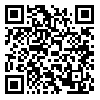Volume 10, Issue 2 (Winter-In Press 2025)
Health in Emergencies and Disasters Quarterly 2025, 10(2): 0-0 |
Back to browse issues page
Download citation:
BibTeX | RIS | EndNote | Medlars | ProCite | Reference Manager | RefWorks
Send citation to:



BibTeX | RIS | EndNote | Medlars | ProCite | Reference Manager | RefWorks
Send citation to:
Sedighi A, Beikzad J, Nejad Haji Ali Irani F, Vedadi A. Designing a Professional Competence Model for Emergency Medical Technicians of the National Emergency Medical Organization. Health in Emergencies and Disasters Quarterly 2025; 10 (2)
URL: http://hdq.uswr.ac.ir/article-1-599-en.html
URL: http://hdq.uswr.ac.ir/article-1-599-en.html
1- Public Administration Department, Bonab Branch, Islamic Azad University, Bonab, Iran., Bonab, Velayat highway, in front of Police Road, Islamic Azad University complex
2- Public Administration Department, Bonab Branch, Islamic Azad University, Bonab, Iran. ,Beikzad.jafar@bonabiau.ac.ir
3- Public Administration, North Tehran Branch, Islamic Azad University, Tehran, Iran, The end of Imam Ali (a.s.) highway north- East Army Blvd.- Sohank neighborhood- Shahid Sohani Blvd.
2- Public Administration Department, Bonab Branch, Islamic Azad University, Bonab, Iran. ,
3- Public Administration, North Tehran Branch, Islamic Azad University, Tehran, Iran, The end of Imam Ali (a.s.) highway north- East Army Blvd.- Sohank neighborhood- Shahid Sohani Blvd.
Abstract: (164 Views)
Background and purpose: Medical emergencies, as the front line of health services and the only way to access valuable clinical emergency medical services on-site, can be considered the health system's main pillars. The competence of the operational emergency technician plays a vital role in reducing mortality rates in accidents. This research aims to design a model for the professional competence of the National Emergency Medical Organization (NEMO) emergency medical technicians.
Research method: The current research was conducted as a combined study. The primary dimensions of the model (axes and sub-axes) were extracted through a literature review. Then, the opinions of 25 experts were used as focus group discussion in three sessions to localize the model, and the model was developed. The opinions of 22 experts in accident and disaster risk management were used to measure the content validity of the model of professional competence of pre-hospital emergency technicians to measure the content validity of dimensions and components.
Findings: The final model included five main axes (attribute, knowledge, skill, ability, and attitude), with 11 sub-axes and 47 items. The results of the content validity test showed that the model and its components were acceptable and valid.
Conclusion: The final model covered all dimensions required for professional qualification. It also covered emergency medical staff-related issues and can be considered a comprehensive and acceptable model. Since it was designed with national and international standards, it can be used as an adequate model in other countries.
Research method: The current research was conducted as a combined study. The primary dimensions of the model (axes and sub-axes) were extracted through a literature review. Then, the opinions of 25 experts were used as focus group discussion in three sessions to localize the model, and the model was developed. The opinions of 22 experts in accident and disaster risk management were used to measure the content validity of the model of professional competence of pre-hospital emergency technicians to measure the content validity of dimensions and components.
Findings: The final model included five main axes (attribute, knowledge, skill, ability, and attitude), with 11 sub-axes and 47 items. The results of the content validity test showed that the model and its components were acceptable and valid.
Conclusion: The final model covered all dimensions required for professional qualification. It also covered emergency medical staff-related issues and can be considered a comprehensive and acceptable model. Since it was designed with national and international standards, it can be used as an adequate model in other countries.
Type of Study: Research |
Subject:
Emergency
Received: 2024/01/12 | Accepted: 2024/07/7 | Published: 2024/01/20
Received: 2024/01/12 | Accepted: 2024/07/7 | Published: 2024/01/20
Send email to the article author
| Rights and permissions | |
 |
This work is licensed under a Creative Commons Attribution-NonCommercial 4.0 International License. |








